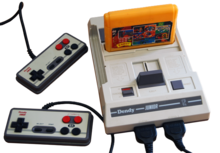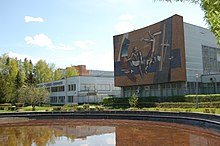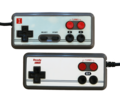Dendy (console)
 | |
 The Dendy Junior with a cartridge and detachable controllers | |
| Developer | Steepler |
|---|---|
| Manufacturer | TXC Corporation Subor "Tensor" factory, Dubna |
| Product family | Famicom hardware clone |
| Type | Home video game console |
| Release date | |
| Discontinued | 1998 |
| Units sold | 1.5[3] to 6[4] million |
| Media | ROM cartridge |
| CPU | Ricoh 2A03 |
Dendy (Russian: Де́нди) is a series of home video game consoles that were unofficial hardware clones of Nintendo's third-generation Famicom system. Produced from late 1992, Dendy consoles were manufactured in Taiwan using Chinese components on behalf of the Russian company Steepler. These consoles were primarily sold in Russia. Over time, production expanded to include assembly at the Chinese Subor factory and the Russian Tenzor factory in Dubna, Moscow Oblast. The Dendy consoles were based on Japanese hardware designs and cartridge formats, which differed slightly from their American counterparts.
The Dendy product line was divided into two categories: the main Classic series and the budget-oriented Junior series. These categories differed in design, quality, and price. The Classic models were replicas of the Micro Genius consoles produced by Taiwan's TXC Corporation and were manufactured in the same factory. The Junior models, developed specifically for Steepler, employed a cost-effective design based on a system-on-a-chip architecture. Steepler also planned to release a Pro version featuring one wired and one wireless gamepad. However, this model was only produced in a single, limited batch.
Because the Famicom and Nintendo Entertainment System were never officially sold in post-Soviet states, the Dendy achieved great popularity in the region. It was promoted through television programs and video game magazines. Dendy became a household name in Russia and began to be applied to the rest of the Famicom hardware clones, colloquially called Famiclones, and to other consoles. After the bankruptcy of Steepler, sales of the original Dendy ceased in 1998, and at the time, according to various estimates, between 1.5 and 6 million units were sold. It is believed that it created a market for video games and game consoles in Russia.
History
[edit]Beginning
[edit]
In 1992, entrepreneur Viktor Savyuk approached Steepler, a company primarily focused on distributing Hewlett-Packard products and localizing the Windows 3.x operating system using the CyrWin package.[2][4] Savyuk proposed the development and sale of television game consoles and interchangeable game cartridges under the Dendy brand.[4] The company's founders, who were also doing in system integration, recognized the potential for expansion into the gaming industry. As a result, Steepler established a "Video Games Department" (Russian: Отдел видеоигр) in September 1992, with Savyuk joining the newly formed division.[2]
Savyuk established connections with Taiwanese console manufacturers and expressed interest in their products. Steepler did not consider selling the original Famicom, as it was three times more expensive than its bootleg clones, and Nintendo showed no interest in the market of Commonwealth of Independent States.[2] Eventually, Steepler made a deal with the Taiwanese firm TXC Corporation, which produced Famiclones and sold them under the Micro Genius brand.[5] The first console sold by Steepler under the Dendy brand was the Micro Genius IQ-501 model, marketed as the Dendy Classic.[2] When choosing the brand name, Savyuk selected the English word for Dandy, referring to a man who pays meticulous attention to aesthetic appearance, behavior, and refined speech. The letter "a" was replaced with "e" for easier reading in Russian.[2] The logo was set in Cooper Black font in red.[6]
Russian animator Ivan Maximov designed the mascot for the Dendy console, which featured a small elephant.[2] The console was promoted through a television advertisement in Russia with the "Dendy, Dendy, we all love Dendy! Dendy — everybody plays!" slogan. The musical group "Neschastny Sluchay" played a significant role in the commercial's creation. Keyboardist Sergey Chekryzhov composed the music, while guitarist Andrey Guvakov developed the slogan. The group also contributed to the commercial's animation.[2] The advertisement was broadcast through Video International company two weeks before the product launch.[2]
The Dendy console was first released on December 17, 1992,[2] with a retail price of 39,000 rubles (equivalent to US$94 at the time).[1][7][8] However, a technical oversight during the market launch resulted in the first batch of consoles using the PAL-I video standard, which was incompatible with the SECAM-DK standard used by most televisions in the Soviet Union. Consequently, the entire initial shipment required repair and video standard conversion in Moscow.[2] The first branded stores opened in Moscow on Petrovka Street, Krasnaya Presnya, and in the underground passage connecting the Teatralnaya metro station to Red Square near GUM department store.[2] By February 1993, sales had reached up to 3,000 units per month. Game sales also proved profitable, prompting Steepler managers to travel to various regions to seek out local dealers and purchase advertising.[2]
Demand for Dendy consoles proved exceptionally high. By April 1993, Steepler had established four regional dealerships and achieved a turnover of 500 million rubles (US$722,000).[9] By autumn of 1993, daily sales reached up to 4,000 units. A consumer demand survey revealed that Dendy ranked third in the "home electronics" category, behind only refrigerators and televisions.[2] The Dendy brand name became genericized, often used to refer to other Famicom hardware clones and even different gaming consoles.[2][9] Steepler had effectively cornered a largely untapped market, as major global video game and console manufacturers showed little interest in Russia at the time. The company's main competition came from the "grey" import market of similar Chinese-made products.[2][9] By the end of 1994, Steepler's annual turnover had reached 75-80 million US dollars. Eventually, the company suspended its advertising campaign due to demand exceeding supply.[2]
Magazines and TV shows
[edit]Steepler's market research into print media led to a partnership with the publishers of Video-Ace Computer Games magazine. This collaboration gave rise to Video-Ace Dendy, a new publication that debuted in summer 1993 under the editorship of Valery Polyakov. Initially, the magazine functioned largely as a promotional vehicle for Steepler's product line, with the first seven issues focusing heavily on Dendy-related content.[2] The magazine's scope was broadened through an agreement with French publisher Hachette Filipacchi-Press, which permitted the reprinting of articles from French gaming magazines Joypad and Joystick. As Steepler's product range expanded to include Sega Mega Drive and Super Nintendo Entertainment System consoles, the magazine's coverage grew to encompass these platforms as well.[2]
After funding delays, the contract to publish the magazine was terminated, and Steepler launched its own magazine, Dendy: The New Reality, published by the Ptyuch magazine editorial staff, with the texts written by Steepler's advertising department. Six issues later, Dendy: The New Reality magazine closed down completely, and the editors of the closed Video-Ace Dendy magazine resumed publication under the name Velikiy Drakon, independently of Steepler.[2]
Beginning in September 1994, the television program Dendy: The New Reality was launched on 2×2 TV channel by Steepler.[2] The host was Sergei Suponev, who had previously hosted Time of Stars and Call of the Jungles. Each episode featured games for Dendy, Mega Drive, and Super NES. The show received high ratings and was very popular. After 33 episodes the program ended, and two months later it was resumed on the ORT channel as a second season with the abbreviated title The New Reality. The second season paid less attention to Dendy games, and in January 1996 the last episode aired.[2] Reasons for the closure were cited as unfortunate airtime, 3:45 p.m. on Fridays, as not all children were home or watching TV at that time,[7] and the production costs for each episode rose from $50,000 to $100,000. Shortly after The New Reality closed, MTK TV Channel launched a TV program called Dendy World, hosted by Semyon Furman and Sergei Gvozdev, which closed after 12 episodes.[2]
Nintendo contract, competition, and downfall
[edit]In 1994, Dendy console sales reached 100,000-125,000 units per month, generating a monthly turnover of $5 million.[2] By 1995, the company expanded its marketing efforts, hiring Russian singer Oleg Gazmanov and his son Rodion as brand ambassadors.[2][10] Additionally, a short animated film titled The Adventures of Dendy the Elephant was produced by the Argus animation studio. Although a 13-episode series was planned, it never materialized.[2] Savyuk later revealed that the company discovered a user loyalty rate exceeding 80%, rendering further advertising unnecessary.[6] Steepler expanded its operations by establishing three new divisions: Steepler Graphic Center for computer graphics creation, Steepler Trading for computer hardware sales, and a programming education center.[2] Shortly thereafter, Steepler underwent a reorganization, resulting in the separation of the Steepler Trading retail network into an independent company called Lamport.[11]
Steepler sought to establish a partnership with Nintendo, attempting to contact the company's European division through its regional office in Germany. Initially, Nintendo did not respond to these overtures. However, upon learning of the popularity of 8-bit console clones in Russia, Nintendo reached out to Steepler in spring 1994. The company invited Victor Savyuk to Seattle for a meeting with Nintendo of America executives Minoru Arakawa and Howard Lincoln.[2][4] Following several days of negotiations, Steepler and Nintendo reached an agreement. Under its terms, Steepler ceased promoting Sega products and obtained exclusive distribution rights for Super Nintendo Entertainment System and Game Boy consoles in Commonwealth of Independent States[2][12] and all post-Soviet states.[13] The agreement also stipulated that Nintendo would refrain from pursuing legal action regarding Dendy sales.[2][4]

At the end of 1994, Steepler had two competitors: Lamport, which began to produce its own Kenga console, and Bitman, which bought Famicom, Mega Drive, and Game Boy clones from Taiwan. Kenga distinguished itself by offering the Ken-Boy portable console, while Bitman signed a formal agreement with Sega under which it began selling licensed Mega Drive 2, Mega CD 2, Mega Drive 32X, Game Gear, Sega Saturn and the educational Sega Pico.[2][14][15] Both companies closed their game businesses a year and a half later; Kenga repositioned itself as a children's goods store, and Bitman was bought out by the R-Style company.[2]
In January 1995, sales dropped noticeably, and an investigation revealed that competitors had started buying consoles in China and were able to reduce prices below the cost of Dendy consoles. At the time, Dendy was still being manufactured in Taiwan.[2] In addition Subor, a Chinese company, entered the market. Subor had previously approached Steepler with a proposal for cooperation, but was rejected. With the support of the Chinese government, Subor opened an office in Moscow and engaged in dumping. After that Subor proposed to Steepler to transfer the production to the Subor factory, making the wholesale price $8–9 as compared to the previous $12 at the Taiwanese factory.[2] The terms were accepted, and an order was placed for 80,000 Dendy consoles at factories in China. In addition, Steepler gained the right to exclusively distribute the Subor SB-225 and SB-225B through its stores, and sales returned to previous levels.[2] In November 1995, Dendy had 10 subsidiaries in the regions and 80 dealers, and retail prices for the consoles dropped to $20.[16]
After the mid-1990s, the 16-bit Mega Drive and Super Nintendo consoles began to give way in the West to next-generation consoles, such as the first PlayStation. In Russia, the era of 8-bit consoles was also coming to an end. Steepler planned to start selling various consumer electronics, such as DVD players, under the Dendy brand. However, those plans fell through when Steepler won a tender to automate the State Duma. Due to opposition from the Federal Agency of Government Communications and Information and assassination attempts on employees, Steepler lost contracts with government agencies and went bankrupt in 1996.[4][2][17] The Dendy division survived as a separate company, even though working capital was held in Steepler accounts, and faced great difficulties. For a time, suppliers sold goods to the company on credit, but when that ran out, the Dendy division was forced to sell stock exclusively for months. Eventually, when the 1998 Russian financial crisis hit, the company closed completely.[4][2]
Some estimates of Dendy sales in Russia are between 1.5 and 2 million consoles, and other estimates range up to 6 million.[4][3] The console gained nostalgic status among those who were children in Russia in the 1990s, similar to the Nintendo and Sega consoles of the same era in the United States, Japan, and Europe. At the time, the name Dendy became synonymous with game consoles that plugged into a television set, and it is believed that it was Dendy that created the video game and game console market in Russia, and that it gave rise to the first generation of Russian gamers.[18][19] Its popularity led to the appearance of counterfeit Dendy clones from other manufacturers. As of 2021, Dendy are collectors' items,[19] and popular among retrogaming fans in Russia.[19][20]
Models
[edit]-
Dendy Classic
-
Dendy Classic II
-
Dendy Classic II controller
-
Dendy Junior
-
Dendy Junior controller
-
Dendy Junior II
-
Dendy Junior II controllers
Dendy was produced in several modifications. In general, the lineup was divided into two categories: the basic Classic and the budget Junior. The first console of the series is a copy of the Taiwanese Micro Genius IQ-501, which was based on the Twin Famicom from Sharp. Taiwan's TXC Corporation reimagined the Twin Famicom design and made the console more compact. Steepler rebranded the IQ-501 as the Dendy Classic and released it on December 17, 1992.[2]
In mid 1993, the Dendy Junior was released, which became "a simplified version of Classic for younger children". The company decided that it was necessary to create a console so cheap that it would be more profitable for wholesalers to buy it from Steepler than from Chinese suppliers. The Dendy Junior was created using cheaper technology and used a system on a chip. The console was originally designed by TXC Corporation on request specifically for Steepler, to compete with the suppliers of Chinese clones, which were of low quality and sold cheaper. The design of the console was copied from the original Famicom, and the box design was done by Rustem Adagamov. The Dendy Junior had a wholesale price of $29, and after its release Classic sales went up.[2]
The next model was the Dendy Junior II, which had a rounded case similar to the Dendy Junior, but the gamepads were non-detachable and the second of them lacked the Start and Select buttons. It was accompanied by the Dendy Junior IIP, which featured a light gun, similar in appearance to the NES Zapper, and a multi-game cartridge.[2]
After the Junior II, the Dendy Junior IVP was released, which missed out on the Junior III name because unknown competitors had released a modified Junior II model under that name. Steepler decided not to compete with them and immediately released the Junior IVP in black, made of cheaper plastic and with a light gun similar to the Beretta M9 included.[2]
The final model in the series was the Dendy Classic II, based on the Micro Genius IQ-502, with a new rounded design and new gamepads. The console was more expensive than the regular Junior versions and was in low demand. There were also plans to release Dendy Pro, based on the Micro Genius IQ-1000, which featured one wired and one wireless gamepad. Savyuk described it to Kommersant newspaper as a console that would "compete with the best Japanese 8-bit consoles",[21] but in the end, he said it only went on sale in a limited batch of 1,000-1,200 units, which sold poorly.[2]
Game cartridges
[edit]
As a Famiclone, Dendy runs Famicom games. A large number of counterfeit copies of NES games, homemade hacked versions of games, and so-called "multi-game" cartridges, such as "99 in 1", were released for the Dendy. However, often, most of the games in the multi-game cartridges do not work, and the rest were essentially copies with minor variations.[3] The first versions of the Dendy cartridges were sold in cases labeled "TV. GAME CARTRIDGE" and with a dust cover.[22] The most popular is the "Cartridge with gulls", with "9999 Games to 1", a menu with gulls flying over the sea, and an 8-bit arrangement of the "Unchained Melody" by The Righteous Brothers.[2]
The Dendy game library is a mix of legitimate games from American, Japanese, and European regions, and unofficial games by Chinese developers.[2] Dendy's cartridges do not have memory for saving, so the games which used it, such as Final Fantasy, The Legend of Zelda and Metroid, never reached the Russian market.[2][23] Steepler's Dendy cartridges yielded a collector market, with prices for game cartridges reaching tens of thousands of rubles as of 2021.[2]
Many counterfeit Dendy games were often created by combining elements from other games and were named after a famous game series, although they actually had nothing to do with it. Such games included Street Fighter V (made long before the real Street Fighter V), Contra 6, and Robocop IV.[24] Many Chinese developers copied games from other consoles for the Dendy and other Famiclones, such as Street Fighter II, Mortal Kombat, and various variants of Disney Interactive games.[2][23] One of the most famous counterfeit Dendy games is Somari, based on Sonic the Hedgehog for the Sega Mega Drive and developed in Taiwan. The protagonist is changed to Mario (wearing Tails's boots) and the game has been slowed down compared to the original, interspersed with elements from Sonic the Hedgehog 2.[3]
When copying official games, counterfeiters often changed the code to remove the logos of game companies, which often accidentally triggered copy protection systems that make the game much more difficult or impossible to beat. Notable examples are Bucky O'Hare (where the game forces you onto the highest difficulty with any shot killing you in one hit), and Teenage Mutant Ninja Turtles III: The Manhattan Project (where the final boss, Shredder, becomes impossible to kill).[2][25]
-
Dendy cartridges
-
Cartridge with a branded Dendy sticker
-
120 in 1 games cartridge (only 7 unique games are included, the rest are repeats)
-
Cartridge boards without cases, the top one is an earlier version with integrated memory chips
See also
[edit]References
[edit]- ^ a b Пичугин, Игорь (18 December 1992). "Steepler начал продавать Dendy — Московская фирма начинает большую видеоигру" (in Russian). Коммерсантъ. Archived from the original on 4 January 2012. Retrieved 20 June 2012.
- ^ a b c d e f g h i j k l m n o p q r s t u v w x y z aa ab ac ad ae af ag ah ai aj ak al am an ao ap aq ar as at au av Kostin, Semyon (14 December 2021). "Легенда о слоне: как IT-компания Steepler создала Dendy и основала российский консольный рынок" [The Legend of the Elephant: How the Steepler IT Company Created Dendy and Founded the Russian Console Market]. DTF (in Russian). Archived from the original on 14 December 2021. Retrieved 15 December 2021.
- ^ a b c d Hill, Mark (22 November 2013). "The Secret History of Knockoff Consoles". The Escapist. Archived from the original on 23 December 2018.
- ^ a b c d e f g h Хохлов, Олег (9 August 2016). "Приставка Dendy: Как Виктор Савюк придумал первый в России поп-гаджет". Секрет фирмы (in Russian). Archived from the original on 12 June 2018. Retrieved 10 June 2018.
- ^ Pichugin, Igor (18 December 1992). "Steepler начал продавать Dendy — Московская фирма начинает большую видеоигру" [Steepler started selling Dendy - Moscow firm starts big video game] (in Russian). Коммерсантъ. Archived from the original on 4 January 2012. Retrieved 20 June 2012.
- ^ a b Верещагин, Андрей (30 October 2017). ""Я боялся, что название будут читать как Дендю" — интервью с создателем бренда Dendy". DTF (in Russian). Retrieved 22 December 2021.
- ^ a b Сударушкин, Дмитрий (February 2013). "Как продавали слона. История становления российского консольного рынка" [How an elephant was sold. History of the formation of the Russian console market]. Хакер (in Russian). No. 169.
- ^ "Мелкооптовая торговля". Коммерсантъ. 21 December 1992. Archived from the original on 15 October 2012. Retrieved 20 June 2012.
- ^ a b c Людмирский, Дмитрий; Пичугин, Игорь (14 April 1993). "Обзор российского рынка видеоигр — Бурный рост приводит к аномалиям" (in Russian). Коммерсантъ. Archived from the original on 6 January 2012. Retrieved 20 June 2012.
{{cite web}}: CS1 maint: multiple names: authors list (link) - ^ "Полугодовые итоги по бизнесу Dendy — К "русскому Nintendo" добавилась японская Sega". Коммерсантъ. 19 July 1994. Archived from the original on 7 August 2011. Retrieved 20 June 2012.
- ^ "Реорганизация Steepler". Коммерсантъ. 1 February 1994. Archived from the original on 8 April 2015. Retrieved 21 September 2011.
- ^ Mandrova, Natalia (26 November 1994). "Реклама: казнить нельзя помиловать" [Advertising: Execution cannot be pardoned]. Коммерсантъ. Archived from the original on 2 January 2012. Retrieved 15 June 2012.
- ^ Pichugin, Igor (1 November 1994). "Соглашение Steepler и Nintendo" [Steepler and Nintendo Agreement]. Коммерсантъ (in Russian). Retrieved 12 February 2022.
- ^ Сергеев-Ценский, Антон (April 1996). "Шаги Командора". Магазин Игрушек (журнал) (in Russian). No. 4 (Магазин Игрушек ed.). Компьютерра. pp. 89–90. ISSN 1819-2734.
- ^ "ВИДЕОПРИСТАВКИ. Новинки в компьютерных играх". Аргументы и факты (in Russian). 19 April 1995. Archived from the original on 31 October 2021. Retrieved 18 December 2021.
- ^ ""Денди" сделала ставку на регионы". Коммерсантъ (in Russian). 2 November 1995. Archived from the original on 13 February 2013. Retrieved 20 June 2012.
- ^ Вадим Резвый (3 April 2004). "Кто подставил слоника Dendy?". Forbes. Archived from the original on 30 April 2012. Retrieved 20 February 2012.
- ^ Calvin, Alex (17 December 2017). "How a counterfeit NES console opened up the Russian games market". Eurogamer. Archived from the original on 26 November 2021. Retrieved 18 December 2021.
- ^ a b c Аликин, Алексей; Ермаков, Дмитрий (7 January 2021). ""Денди" навсегда: почему россияне до сих пор играют в приставку". РИА Новости (in Russian). Retrieved 12 January 2022.
{{cite web}}: CS1 maint: multiple names: authors list (link) - ^ Toohey, Nathan (2010). "Retro-kitsch in Moscow's time machine". The Moscow News.
- ^ Пичугин, Игорь (14 April 1993). "Российский рынок видеоигр расширяется – Steepler выпустит еще три игровые приставки" (in Russian). Коммерсантъ. Archived from the original on 19 March 2017. Retrieved 17 December 2021.
- ^ Костин, Семён (16 March 2017). "Эпоха Dendy: как появились консоли в России". DTF (in Russian). Retrieved 17 December 2021.
- ^ a b Никифоров, Кирилл (5 October 2020). "Играют все! Краткая история фирмы Steepler и главной российской консоли Dendy". Игромания (in Russian). Retrieved 12 January 2022.
- ^ Plunkett, Luke (13 December 2011). "Street Fighter V? Contra 6? These Games Exist (In Russia)". Kotaku. Archived from the original on 7 May 2021. Retrieved 16 December 2021.
- ^ Mckeague, Matt (31 December 2014). "How Game Companies Fight Piracy by Torturing Cheap Players". Guff. Archived from the original on 23 July 2015. Retrieved 14 November 2017.
Further reading
[edit]- Горж, Флоран (2020). История Nintendo. Книга 3. Famicom. ISBN 978-5604370148.
External links
[edit]![]() Media related to Dendy (console) at Wikimedia Commons
Media related to Dendy (console) at Wikimedia Commons











